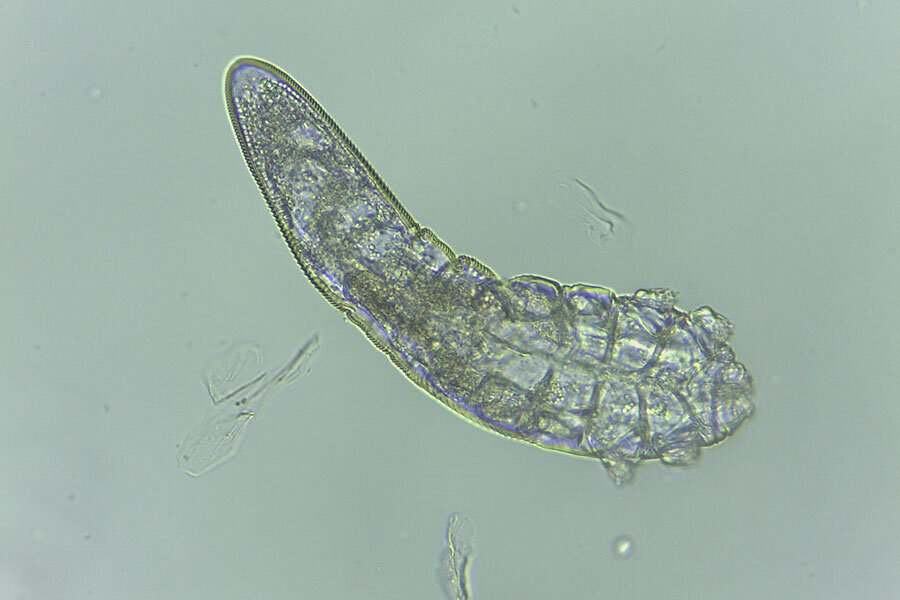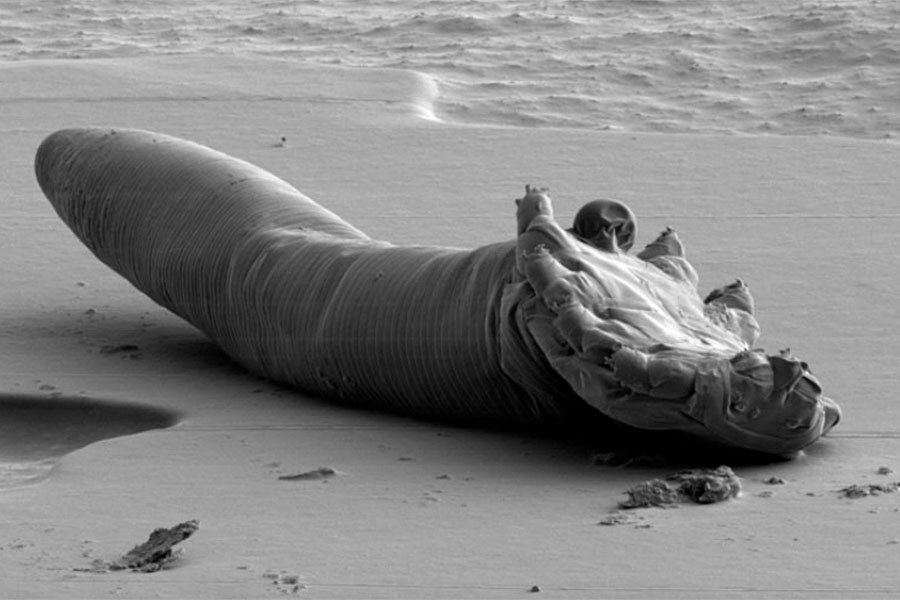What the tiny mites on our faces reveal about our history
Loading...
Little mites make their home all over the bodies of many plants and animals, including humans. And the tiny bugs living on us could tell us something about our past.
The genetic diversity of the human face mite, Demodex folliculorum, is actually linked to the ancestry of the microscopic animals' hosts, scientists say.
As humans evolved and migrated across the globe, the mites hitched a ride and evolved with them. So the lineages of mites found on people's faces today reflect where their ancestors lived, according to a paper published Monday in the Early Edition of the journal Proceedings of the National Academy of Sciences.
"We have these arachnids that live on our faces," explains California Academy of Sciences entomologist Michelle Trautwein, senior author of the study, in an interview with The Christian Science Monitor. "People may think of them as just parasites on our faces, but the truth is, we can look at their genetics and learn more about ourselves and our own history."
Mites have coexisted with humans throughout our evolutionary history, the scientists say. These mites, which are typically harmless, live in the hair follicles covering human bodies, but prefer the oily and greasy areas like faces.
The researchers found that Europeans and people of European ancestry tended to host just one lineage of mites. People of African, Asian, or Latin American ancestry showed a much greater diversity of mites, with three additional lineages populating their faces.
"We get a signal that the oldest lineages of this mite live on people of African and Asian origin," Dr. Trautwein says. "If you think about humans migrating out of Africa, that's exactly what we'd expect."
Trautwein and her colleagues have found new support for the widely accepted out-of-Africa dispersal theory, which suggests modern humans first emerged in Africa before different groups trekked to different regions across Eurasia. Those populations would have evolved slightly differently over time depending on their environment. And the mites they carried would have evolved right along with them.
Even if a person was many generations removed from their continent of ancestry, like some African Americans are, that person's face mite population would still show a deep connection to that ancestral region.
"The fact that we maintain our mites over time" Trautwein says shows "they're not transmitted very easily."
"They're really only shared between close family members. You need a lot of physical contact to share mites," she explains. "You're not sharing them with people on the subway or casually. And that's what allows them to reflect our history. If we were sharing them everywhere, we wouldn't get this cool evolutionary signal."
The researchers scraped material off the faces of 70 people who were either visiting the United States from other regions, immigrated to the country or were born in the US. The scientists then extracted their mites' DNA and sequenced it, focusing in on the mitochondrial DNA to map the mites' lineages.
"This was really exploratory research," Trautwein says. "This study just creates this basic foundation that shows us that these arachnids may be a cool tool for understanding more about the history of human migration."
And, she says, "This paper doesn't reveal any of our deep secrets yet, but I think it's a system that potentially really could."
George Perry, the principal investigator for the Anthropological Genomics Laboratory at Pennsylvania State University, who is not affiliated with the study, called this paper a "jumping off point."
"It's exciting to think about human population history and diversity as more than just ourselves," Dr. Perry tells The Christian Science Monitor in an interview.
Perry says he's particularly curious about the apparent lack of diversity among the mites on European and European-descended human populations. "Now why is that?" he says. "That's the interesting question."
This isn't the first time parasites have been linked to human evolution. Perry authored an overview of such findings in 2014.
In his paper, Perry writes, "Many parasites flourish only in the presence of very specific human behaviors and in specific habitats, are wholly dependent on us, and have evolved with us for thousands or millions of years."
One example Perry cites is research that suggests bedbugs first found their way to human beds when people were living in caves. In that scenario, the bedbugs would have been initially living on bats, but saw humans' bedding as another inviting option.
The presence of lice helped researchers identify human's early clothing use, according to another study cited by Perry.
In both scenarios, the parasites' presence say something about a change in human behavior. With the bedbugs, the humans were using bedding to sleep on hard cave floors, while the clothed ancient humans made attractive hosts to head lice. Both parasites held clues into human history.
Or as Perry puts it in his article, "by asking when and how we first acquired those parasites, under which environmental and cultural conditions we are the most susceptible, and how the parasites have evolved and adapted to us and we in response to them, we can gain considerable insight into our own evolutionary history."









